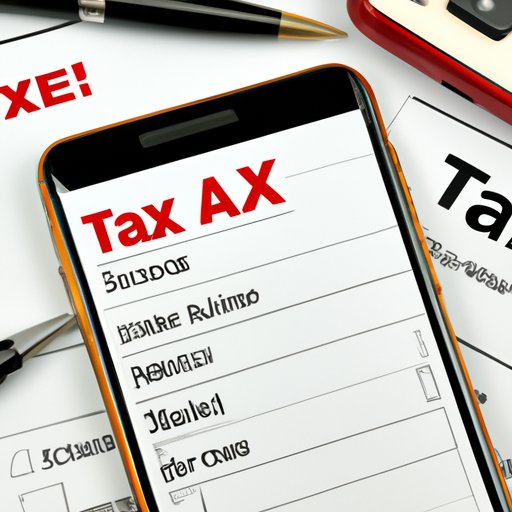
How to File Your Taxes: A Step-by-Step Guide with Tips and Strategies
The mere thought of filing taxes can seem daunting. While the process may seem complicated, it doesn’t have to be. By following a step-by-step guide and arming yourself with knowledge on deductions and commonly made mistakes, you can file your taxes with ease. In this article, we’ll explore how to gather your necessary paperwork, complete tax forms, and file your taxes. We’ll also take a look at popular tax software options, common tax deductions, and tips for freelancers. Let’s get started!
Step-by-Step Guide
Before diving into the specifics of tax preparation, it’s important to get organized. Gather all of your necessary paperwork in one place, including forms W-2, 1099, and any receipts for expenses or charitable donations. It’s also a good idea to have last year’s tax return accessible for reference.
When organizing your information, one helpful tip is to separate items by category. For example, group all of your charitable donations together and all of your expenses together. This makes the process of filling out forms less overwhelming.
Next, it’s time to get familiar with the tax forms. The most common forms used are the 1040, 1040EZ, and 1040A. The form you use depends on your personal situation, such as whether you have dependents or if you’re self-employed. Be sure to read the instructions on each form carefully to ensure you’re filling out the right one.
When completing the forms, double-check for accuracy. Simple mistakes, such as incorrect social security numbers or math errors, can delay your return or result in additional fees.
After completing the forms, it’s time to submit. You can do this either electronically or by mail. Filing electronically is generally faster and more convenient, while mailing a paper copy may take longer but is still an option.
If you’re eligible for a refund, the IRS typically issues it within three weeks if you filed electronically or six weeks if you mailed the return. You can check the status of your refund on the IRS website.
Tax Software Comparison
For those who prefer to file their taxes electronically, there are several popular software options available. Each service offers unique features and pricing structures. Here are some of the most popular options:
- H&R Block
- TurboTax
- TaxAct
- FreeTaxUSA
When choosing a tax software, there are several things to consider. Firstly, compare the prices of each service. Some offer free versions for simple returns, while others may charge a fee or offer paid upgrades for more complex situations. Be sure to consider your personal situation when choosing.
It’s also important to consider user-friendliness and customer support. A software that’s easy to navigate and offers helpful customer service can make the filing process more manageable.
Finally, consider the pros and cons of each software option. For example, H&R Block offers in-person assistance at their physical locations, while TurboTax offers a feature where users can connect with a live CPA for additional support. Consider your personal needs and preferences when choosing a software.
Common Tax Deductions
Tax deductions can greatly reduce the amount owed on your return or increase your refund. Deductions are amounts you can subtract from your gross income to lower your taxable income. Some common deductions include:
- Mortgage interest
- Charitable contributions
- Student loan interest
- Medical expenses
- State and local taxes
It’s important to note that not everyone is eligible to claim each deduction. Be sure to research the eligibility requirements for each deduction before claiming it on your return.
When claiming deductions, keep accurate records of your expenses. This includes receipts, bank statements, and any other relevant documentation. If you’re ever audited, having detailed records can save you from penalties and fees.
Filing Tips for Freelancers
Freelancers have unique tax situations to consider. One important thing to note is self-employment tax. This tax is separate from income tax and covers social security and medicare taxes for self-employed individuals.
To prepare for tax season, keep detailed records of your income and expenses. This includes invoices, receipts, and bank statements. Consider using accounting software to help manage your finances.
There are also several expenses that freelancers can deduct on their tax return. These include office supplies, equipment, and even a portion of your rent or mortgage if you work from home. Keep a detailed record of these expenses and consult with a tax professional if needed.
Tax Filing Mistakes to Avoid
There are several common mistakes taxpayers make when filing their returns. These include:
- Math errors
- Incorrect social security numbers
- Forgetting to sign and date the return
- Missed deadlines
To prevent these mistakes, double-check all information on your return before submitting. Use a calculator to ensure your math is correct and be sure to sign and date the return. Mark important deadlines in your calendar to avoid missing them.
If you’re uncertain about any aspect of your return, consider consulting with a tax professional. While this may cost money upfront, it can save you from costly mistakes in the long run.
Understanding Tax Forms
Finally, it’s important to understand the different tax forms and their uses. Here are some of the most commonly used forms:
- Form W-2: reports wages, tips, and other compensation paid to an employee
- Form 1099: reports non-wage income, such as contractor or freelance income
- Form 1040: the main tax form used by individuals to report their income
When filling out tax forms, be sure to include all necessary information. For example, if you received several 1099 forms, ensure you include information from each on your return.
Conclusion
By following a step-by-step guide and understanding key deductions and mistakes to avoid, filing taxes can be a manageable process. Consider using tax software to help ease the process and keep accurate records of all of your information. Remember, accuracy is key when filing taxes. Seek additional resources if needed, such as tax professionals or online guides.




